Słupsk
Słupsk
Stôłpsk(Kashubian) | |
|---|---|
From top, left to right: City Hall, Mill Gate,Pomeranian Dukes' Castle,Słupsk County Office | |
| Coordinates:54°27′57″N17°1′45″E/ 54.46583°N 17.02917°E | |
| Country | |
| Voivodeship | |
| County | city county |
| Established | 10th century |
| City rights | 1265 |
| Government | |
| • City mayor | Krystyna Danilecka-Wojewódzka (L) |
| Area | |
| • Total | 52.7 km2(20.3 sq mi) |
| Elevation | 22 m (72 ft) |
| Population (31 December 2021) | |
| • Total | 88,835 |
| Time zone | UTC+1(CET) |
| • Summer (DST) | UTC+2(CEST) |
| Postal code | 76-200 to 76-210, 76-215, 76-216, 76-218, 76-280 |
| Area code | +48 059 |
| Car plates | GS |
| Website | slupsk.pl |
Słupsk(Polish:[swupsk];Kashubian:Stôłpsk[stɞwpsk];German:Stolp[ʃtɔlp]) is acity with powiat rightslocated on theSłupia Riverin thePomeranian Voivodeshipin northernPoland,in the historical region ofPomeraniaor more specifically in its part known in contemporary Poland asCentral Pomerania(Pomorze Środkowe) within the wider West Pomerania (Pomorze Zachodnie). According toStatistics Poland,it has a population of 88,835 inhabitants while occupying 43.15 square kilometres (16.66 sq mi), thus being one of the most densely populated cities in the country as of December 2021.[1][2][3]In addition, the city is the administrative seat ofSłupsk Countyand the ruralGmina Słupsk,despite belonging to neither, while until 1999 it was the capital ofSłupsk Voivodeship.
Słupsk had its origins as a Pomeranian settlement in the earlyMiddle Ages.In 1265, it was giventown rights.By the 14th century, the town had become a centre of local administration and trade and aHanseatic Leagueassociate. Between 1368 and 1478, it was a residence of theDukes of Słupsk,until 1474 vassals of theKingdom of Poland.In 1648, according to thepeace treatyofOsnabrück,Słupsk became part ofBrandenburg-Prussia.In 1815, it was incorporated into the newly formed PrussianProvince of Pomerania.AfterWorld War II,the city again became part of Poland, as it fell within the new borders determined by thePotsdam Conference.
Etymology[edit]
Slavic names inPomeranian—Stolpsk,[4]Stôłpsk,Słëpsk,Słëpskò,Stôłp[5]— andPolish—Słupsk— may be etymologically related to the wordssłup'pole' andstołp'keep'. There are two hypotheses about the origin of those names: that it refers to a specific way of constructing buildings on boggy ground with additional pile support, which is still in use, or that it is connected with a tower or other defensive structure on the banks of the Słupia River.[4]
Later, under German administration, the town was namedStolp,to which the suffixin Pommernwas attached in order to avoid confusion with other places similarly named. The Germanised name comes from one of five Slavic Pomeranian names of this settlement.[4]The city was occasionally calledStolpe,referring to theSłupia River,whose German name isStolpe.Stolpeis also theLatinexonym for this place.[6]
History[edit]
Middle Ages[edit]

Słupsk developed from a fewmedievalsettlements located on the banks of theSłupia River,at the uniquefordalong thetrade routeconnecting the territories of modernPomeranianandWest PomeranianVoivodeships. This factor led to the construction of agrod,aWest SlavicorLechiticfortified settlement, on an islet in the middle of the river. Surrounded by swamps and mires, the fortress had perfect defence conditions. Archaeological research has shown that the grod was situated on an artificial hill and had a naturalmoatformed by the branches of the Słupia, and was protected by apalisade.Records confirm that the area of Słupsk was part of the Polish realm during the reign ofMieszko Iand in the 11th century.[7]

According to several sources, the first historic reference to Słupsk comes from the year 1015 when the king of PolandBoleslaus I the Bravetook over the town, incorporating it into the Polish state. In the 12th century, the town became one of the most important castellanies in Pomerania alongsideGdańskandŚwiecie.[8]However, several historians stated that the first mention was in two documents dating to 1227, signed by thePomeranian dukesWartislaw IIIandBarnim Iand their mothers, confirming the establishment of an abbey in 1224 and donating estates, among them a village "in Stolp minore" or "in parvo Ztolp", respectively, to that abbey.[9]Another document dated to 1180, which mentions a "castellania Slupensis" and would thus be the oldest surviving record, has been identified as a late 13th-century or 14th-century duplicate.[9]

TheGriffin dukeslost the area to theSamboridesduring the following years, and the next surviving documents mentioning the area concern donations made by SamborideSwietopelk II,dating to 1236 (two documents) and 1240.[10]In the earlier of the two 1236 documents, a Johann "castellanus de Slupcz" is mentioned as a witness,[11]Schmidt considers this to be the earliest mention of the gard, since a castellany required the existence of a gard.[12]The first surviving record explicitly mentioning the gard is from 1269: it notes a "Christianus, castellanus in castro Stolpis, et Hermannus, capellanus in civitate ante castrum predictum", thus confirming the existence of a fortress ( "castrum" ) with a suburbium ( "civitas" ).[12]Schmidt further says that the office of a capellanus required a church, which he identifies as Saint Peter's.[12]This church is mentioned by name for the first time in a 1281 document of SamborideMestwin II,which also mentions Saint Nicolai church and a Saint Mary's chapel in the fortress.[13]The oldest mention of Saint Nicolai church dates to 1276.[13]
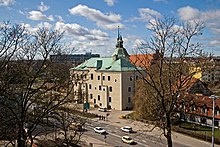
Modern Słupsk possibly received itscity rightsin 1265.[14]Historians argue that city rights were granted for the first time[13]in a document dated 9 September 1310 whenBrandenburgian margravesWaldemarand Johann V granted those privileges underLübeck law,which was confirmed and extended in a second document, dated 2 February 1313.[13]The margraves had acquired the area in 1307.Mestwin IIaccepted them as his superiors in 1269, confirmed in 1273,[15]but later on, in 1282, Mestwin II and Polish DukePrzemysł IIsigned theTreaty of Kępno,which transferred the suzerainty overGdańsk Pomeraniaincluding Słupsk to Przemysł II. After Mestwin II's death the city was reintegrated with Poland and remained Polish until 1307, when theMargraviate of Brandenburgtook over, while leaving local rule in the hands of theSwenzonesdynasty, whose members were castellans in Słupsk.[16]In 1337, the governors of Słupsk (Stolp) had purchased the village ofStolpmünde(modern Ustka)[7]and then constructed a port there, enabling a maritime economy to develop. After theTreaty of Templinin 1317 the city passed to theDuchy of Pomerania-Wolgast.[17]
In 1368Pomerania-Stolp(Duchy of Słupsk) was split off from Pomerania-Wolgast due to thePartitions of the Duchy of Pomerania.The grandson of Polish KingCasimir III the Greatand his would-be successorCasimir IVbecame duke of Słupsk as a Polishvassalin 1374, after he failed to take the Polish throne. The succeeding dukes were also vassals of the Kings of Poland:Wartislaw VIIpaid homage in 1390 (to KingWładysław II Jagiełło),[18]Bogislaw VIIIpaid homage in 1410 (also to King Władysław II).[7]Słupsk remained within Polish sphere of political influence until 1474. It became part of theDuchy of Pomeraniain 1478.
Modern ages[edit]

TheProtestant Reformationreached the town in 1521, when Christian Ketelhut preached in the town. Ketelhut was forced to leave Stolp in 1522 due to an intervention byBogislaw X, Duke of Pomerania.Peter Suawe, a Protestant from Stolp, however, continued his practices. In 1524, Johannes Amandus fromKönigsbergand others arrived and preached in a more radical way. As a consequence, Saint Mary's Church was profaned, the monastery's church was burned, and the clergy were treated poorly.[19]The inhabitants of the town began the process of conversion toLutheranism.In 1560 Polish pastor Paweł Buntowski preached in the town, and in 1586 Polish religious literature spread locally.[7]
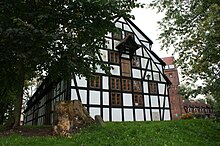
TheHouse of Griffins,which ruled Pomerania for centuries, died out in 1637. The territory was subsequently partitioned betweenBrandenburg-PrussiaandSweden.After thePeace of Westphalia(1648) and theTreaty of Stettin (1653),Stolp came under Brandenburgian control. In 1660, theKashubian dialectwas allowed to be taught, but only in religious studies.[7]The Polish language in general, however, was experiencing very unfavourable conditions due to depopulation of the area in numerous wars and impliedGermanization.[20]
After theThirty Years' War,Stolp lost much of its former importance—despite the fact thatSzczecinwas thenruled by Sweden,the province's capital was situated not in the second-largest city of the region, but in the one closest to the former ducal residence—Stargard.However, the local economy stabilized. The constant dynamic development of theKingdom of Prussiaand good economic conditions saw the city develop. After the major state border changes (modernVorpommernand Stettin joined the Prussian state after a conflict withSweden) Stolp was only an administrative centre of theKreis(district) within theRegierungsbezirkofKöslin(Koszalin). However, its geographical location led to rapid development, and in the 19th century, it was the second city of the province in terms of both population and industrialization.
In 1769,Frederick II of Prussiaestablished a military school in the city, according toStanisław Salmonowiczits purpose was theGermanizationof local Polish nobility.[21]
During theNapoleonic Wars,the city was taken by 1,500 Polish soldiers under the leadership of generalMichał Sokolnickiin 1807.[7]In 1815 Słupsk became one of the cities of theProvince of Pomerania (1815–1945),in which it remained until 1945. In 1869 a railway fromDanzig(Gdańsk) reached Stolp.

During the 19th century, the city's boundaries were significantly extended towards the west and south. The new railway station was built about 1,000 metres from the old city. In 1901, the construction of a new city hall was completed, followed by a local administration building in 1903. In 1910 a tram line was opened. The football clubViktoria Stolpwas formed in 1901. In 1914, before theFirst World War,Stolp had approximately 34,340 inhabitants.
Interwar period[edit]
Stolp was not directly affected by the fighting in theFirst World War.The trams did not operate during the war, returning to the streets in 1919. Demographic growth remained high, although development slowed, because the city became peripheral, theKreis(district) being situated on post-war Germany's border with thePolish Corridor.Polish claims to Stolp and its neighbouring area were refused during theTreaty of Versaillesnegotiations. The city, having become the regional center of the eastern part of Eastern Pomerania, thrived, becoming known asLittle Paris.A cultural highlight was an annual art exhibition.[22]
From 1926 the city became an active point ofNazisupporters, and the influence ofNSDAPgrew rapidly.[7]The party with Hitler received 49.1% of the city's vote in theGerman federal election of March 1933,[23]when however, the election campaign was marked by Nazi terror.[citation needed] During theKristallnacht,the night of 9/10 November 1938, the localsynagoguewas burned down.[24]
Second World War[edit]
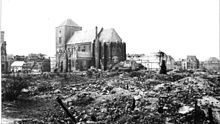
The beginning of theSecond World Warhalted the development of the city. The Nazis created alabour campnear Słupsk, which becameAußenarbeitslager Stolp,a subcamp of theStutthof concentration camp.During the war, Germans brought forced labourers from occupied and conquered countries and committed numerous atrocities. People in the labour camp were maltreated physically and psychologically and forced to undertake exhausting work while being subject to starvation.[25]
Between July 1944 and February 1945, 800 prisoners were murdered by Germans in a branch of the Stutthof camp located in a railway yard in the city; today a monument honours the memory of those victims.[24]Other victims of German atrocities included 23 Polish children murdered between December 1944 and February 1945, and 24 Polishforced labourers(23 men and one woman) murdered by theSchutzstaffel(SS) on 7 March 1945, just before theRed Armytook over the city without any serious resistance on 8 March 1945.[24]In fear of Soviet repression, up to 1,000 inhabitants committed suicide.[24][26] Thousands remained in the city; the others had fled and the German soldiers abandoned it. However, the Soviet soldiers were ordered to set fire to the historical central Old Town, which was almost completely destroyed.[citation needed]
Post-war period[edit]

After the war, the city became again part of Poland and most of the German population either fled orwas expelledin accordance with thePotsdam Agreement.The city was settled by Poles, most of whom were expelled from theformer Polish eastern territories annexed by the Soviet Union(around 80% at the end of 1945) and the rest were mainly repatriates from theSoviet Unionand Poles returning from Germany.[27]AlsoUkrainiansandLemkossettled into the town duringOperation Vistula.
The town's name was changed into the historic Polish version ofSłupskby theCommission for the Determination of Place Nameson 23 April 1945. It was initially part ofOkręgIII,comprising the whole territory of the formerProvince of Pomeraniaeast of theOder River.Słupsk later became part ofSzczecin Voivodeshipand thenKoszalin Voivodeship,and in 1975 became the capital of the new province ofSłupsk Voivodeship.
Life in the devastated city was organized anew. In 1945, the first post-war craft workshops and public schools were opened, trams and a regional railway started to operate, and the amateur Polish Theater was established.[27]In September 1946, the firstWarsaw UprisingMonument in Poland was unveiled.[27]From April 1947, the local Polish newspaperKurier Słupskiwas published.[27]The city became a cultural centre. In the 1950s, the Puppet TheaterTęcza,the Teachers' College and the Baltic Dramatic Theater were established.[27]The puppet theatreTęczaused to collaborate with the similar institution calledArcadiainOradea,Romania,but the partnership ceased after 1989. The Millennium Cinema was one of the first in Poland to have acinerama.The first Polishpizzeriawas established in Słupsk in 1975.[28]
During the1970 proteststhere were minor strikes and demonstrations. None were killed during themilitia's interventions.
After 1989[edit]
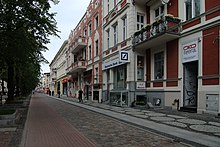
Major street name changes were made in Słupsk after theRevolutions of 1989.Also, a process of major renovations and refurbishments began, beginning in the principal neighbourhoods. According to theadministrative reform of Polandin 1999,Słupsk Voivodeshipwas dissolved and divided between two larger regions:Pomeranian VoivodeshipandWest Pomeranian Voivodeship.Słupsk itself became part of the former. The reform was criticized by locals, who wanted to create a separate Middle Pomeranian Voivodeship.[29]In 1998 a majorriottook place after a basketball game.
In 2014, Słupsk elected Poland's first openly gay mayor,Robert Biedroń.[30]
Geography[edit]
Boundaries[edit]
Administratively, the city of Słupsk has the status of both an urbangminaand a citycounty(powiat). The city boundaries are generally artificial, with only short natural boundaries around the villages ofKobylnicaandWłynkówkoon theSłupia River.The boundaries have remained unchanged since 1949, when Ryczewo became a part of the city.
Słupsk shares about three-quarters of its boundaries with the rural district calledGmina Słupsk,of which Słupsk is the administrative seat (although it is not part of the district). The city's other neighbouring district isGmina Kobylnica,to the south-west. TheSłupsk Special Economic Zoneis not entirely contained within the city limits: a portion of it lies within Gmina Słupsk, while some smaller areas are at quite a distance from Słupsk (Debrzno), or even in another voivodeship (Koszalin,Szczecinek,Wałcz).

The city has a fairly irregular shape, with its central point atPlac Zwycięstwa( "Victory Square" ) at54°27′51″N17°01′42″E/ 54.46417°N 17.02833°E.
Topography[edit]

Słupsk lies in anpradolinaof theSłupia River.The city centre is situated significantly lower than its western and easternmost portions. Divided into two almost equal parts by the river, Słupsk is hilly when compared to other cities in the region. About 5 square kilometres (1.9 sq mi) of the city's area is covered by forests, while 17 square kilometres (6.6 sq mi) is used for agricultural purposes.
Słupsk is rich in natural water bodies. There are more than twentyponds,mostly former meanders of the Słupia, within the city limits. There are also severalstreams,irrigationcanals(generally unused and abandoned) and aleat.Except in the city centre, all these watercourses are unregulated.
There is generally little human influence on landform features visible within the city limits. However, in the northwestern part of the city there is a hugehollow,a remnant of a formersand mine.Although there were once plans to build awaterparkin this area,[31]they were later abandoned and the site remains unused.
Climate[edit]
Słupsk has atemperatemarine climate,like the rest of the Polish coastal regions.[32]The city lies in a zone where thecontinental climateinfluences are very weak compared with other regions of Poland.[33]The warmest month is July, with an average temperature range of 11 to 21 °C (52 to 70 °F). The coolest month is February, averaging −5 to 0 °C (23 to 32 °F). The wettest month is August with average precipitation of 90 millimetres (3.5 in), while the driest is March, averaging only 20 millimetres (0.79 in). Snowfalls are always possible between December and April.
| Climate data for Słupsk (1951–1980 normals, extremes 1951–1965 and 1987–1992) | |||||||||||||
|---|---|---|---|---|---|---|---|---|---|---|---|---|---|
| Month | Jan | Feb | Mar | Apr | May | Jun | Jul | Aug | Sep | Oct | Nov | Dec | Year |
| Record high °C (°F) | 12.3 (54.1) |
18.1 (64.6) |
21.3 (70.3) |
26.7 (80.1) |
30.6 (87.1) |
33.9 (93.0) |
36.0 (96.8) |
34.9 (94.8) |
29.8 (85.6) |
22.7 (72.9) |
17.3 (63.1) |
13.7 (56.7) |
36.0 (96.8) |
| Mean maximum °C (°F) | 7.0 (44.6) |
7.8 (46.0) |
12.9 (55.2) |
21.1 (70.0) |
25.1 (77.2) |
29.2 (84.6) |
30.0 (86.0) |
28.9 (84.0) |
26.6 (79.9) |
19.7 (67.5) |
12.6 (54.7) |
9.7 (49.5) |
31.3 (88.3) |
| Mean daily maximum °C (°F) | 1.4 (34.5) |
1.2 (34.2) |
4.9 (40.8) |
11.5 (52.7) |
16.2 (61.2) |
20.7 (69.3) |
21.6 (70.9) |
21.3 (70.3) |
18.2 (64.8) |
12.9 (55.2) |
6.6 (43.9) |
3.0 (37.4) |
11.6 (52.9) |
| Daily mean °C (°F) | −1.1 (30.0) |
−1.8 (28.8) |
1.0 (33.8) |
6.4 (43.5) |
11.0 (51.8) |
15.6 (60.1) |
16.8 (62.2) |
16.3 (61.3) |
12.9 (55.2) |
8.6 (47.5) |
3.9 (39.0) |
0.7 (33.3) |
7.5 (45.5) |
| Mean daily minimum °C (°F) | −4.1 (24.6) |
−5.1 (22.8) |
−2.7 (27.1) |
1.9 (35.4) |
5.7 (42.3) |
9.8 (49.6) |
12.0 (53.6) |
11.9 (53.4) |
8.5 (47.3) |
4.9 (40.8) |
1.3 (34.3) |
−1.8 (28.8) |
3.5 (38.3) |
| Mean minimum °C (°F) | −15.9 (3.4) |
−15.4 (4.3) |
−11.7 (10.9) |
−3.7 (25.3) |
−0.6 (30.9) |
3.4 (38.1) |
6.5 (43.7) |
6.5 (43.7) |
1.7 (35.1) |
−1.2 (29.8) |
−5.7 (21.7) |
−11.4 (11.5) |
−19.2 (−2.6) |
| Record low °C (°F) | −31.2 (−24.2) |
−28.6 (−19.5) |
−19.8 (−3.6) |
−6.8 (19.8) |
−2.8 (27.0) |
−0.6 (30.9) |
4.5 (40.1) |
2.8 (37.0) |
−0.6 (30.9) |
−7.3 (18.9) |
−13.7 (7.3) |
−19.6 (−3.3) |
−31.2 (−24.2) |
| Averageprecipitationmm (inches) | 53.4 (2.10) |
43.9 (1.73) |
39.1 (1.54) |
46.8 (1.84) |
57.7 (2.27) |
58.6 (2.31) |
98.7 (3.89) |
85.1 (3.35) |
77.2 (3.04) |
74.5 (2.93) |
72.1 (2.84) |
64.0 (2.52) |
771.2 (30.36) |
| Average precipitation days(≥ 0.1 mm) | 18.1 | 15.2 | 12.9 | 13.0 | 13.1 | 10.9 | 14.7 | 13.6 | 14.8 | 15.1 | 17.3 | 17.8 | 176.5 |
| Averagerelative humidity(%) | 85.3 | 84.1 | 80.8 | 79.4 | 76.6 | 75.9 | 81.0 | 82.5 | 83.7 | 85.7 | 87.2 | 86.5 | 82.4 |
| Averagedew point°C (°F) | −3 (27) |
−2 (28) |
0 (32) |
3 (37) |
7 (45) |
11 (52) |
14 (57) |
14 (57) |
11 (52) |
6 (43) |
4 (39) |
0 (32) |
5 (42) |
| Mean monthlysunshine hours | 86.8 | 90.4 | 164.3 | 270.0 | 279.0 | 291.0 | 285.2 | 306.9 | 243.0 | 145.7 | 111.0 | 86.8 | 2,360.1 |
| Averageultraviolet index | 2 | 2 | 2 | 4 | 4 | 5 | 5 | 5 | 4 | 3 | 1 | 1 | 3 |
| Source 1: Meteomodel.pl[34][35] | |||||||||||||
| Source 2: Weather Atlas (UV),[36]Time and Date (dewpoints, 2005-2015)[37] | |||||||||||||
Neighbourhoods[edit]
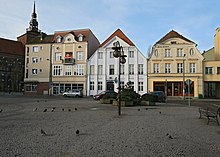

The neighbourhoods (osiedla,singularosiedle) of Słupsk do not have any administrative powers. Their names are used for traffic signposting purposes and are shown on maps. The neighbourhoods are as follows:
- Nadrzecze( "Riverside" ) — situated in the southern part of the city, this district is a major industrial area. It is bounded by the railroad to the west,DeotymyandJana Pawła IIstreets to the north, the Słupia river to the east and the city boundary to the south.
- Osiedle Akademickie( "Academic Neighbourhood" ) — a neighbourhood ofdetachedandsemi-detachedhouses around thePomeranian Academyand itshalls of residence.
- Osiedle Bałtyckie( "Baltic Neighbourhood" ) — the northernmost neighbourhood of Słupsk, a large part of which belongs to theSłupsk Special Economic Zone.
- Osiedle Niepodległości( "Independence Neighbourhood" ) (before 1989 calledOsiedle Budowniczych Polski Ludowejor "Neighbourhood of the Builders of People's Poland", and still popularly referred to asBPL) andOsiedle Piastów( "PiastNeighbourhood ") — these neighbourhoods make up the largest residential area of the city, inhabited by about 40,000 people.
- Osiedle Słowińskie( "SlovincianNeighbourhood ") — the easternmost part of Słupsk, similar in character to Osiedle Akademickie. It adjoins the Northern Wood (Lasek Północny) and is close to the city's boundary withRedzikowo,the planned site of theUS national missile defenseinterceptors.
- Ryczewo— brought within the city limits in 1949, this is the youngest neighbourhood of Słupsk. Before theSecond World Warit was a villa district. It has retained much of its village character.
- Stare Miasto( "Old Town"; also known asŚródmieścieorCentrum— "the City Centre" ) — the central district of Słupsk containing the historic centre of the city including the city hall and the Pomeranian Dukes' Castle.
- Westerplatte(known also asOsiedle Hubalczyków-Westerplatte) — a large and fast-developing area in the south-east of Słupsk, including the city's highest point. Currently both detached houses and blocks of flats are being built here.
- Zatorze(usually further subdivided intoOsiedleJana III SobieskiegoandOsiedleStefana Batorego) — the second largest residential area, with 10,000 inhabitants. According to police statistics, it is the most dangerous area of the city.
Parks[edit]
Słupsk has many green areas within its boundaries. The most important are the Park of Culture and Leisure (Park Kultury i Wypoczynku), the Northern Wood (Lasek Północny) and the Southern Wood (Lasek Południowy). There are also many small parks, squares and boulevards.
Transport[edit]
Railways[edit]

Słupsk is a railway junction, with four lines running north, west, east and south from the city.[38]Currently, one station, opened January 10, 1991 serves the whole city. This is a class B station according toPKP(Polish Railways) criteria.[39]The city has rail connections with most major cities in Poland:Białystok,Gdańsk,Gdynia,Katowice,Kraków,Lublin,Łódź,Olsztyn,Poznań,Szczecin,WarsawandWrocław,and also serves as a junction for local trains fromKołobrzeg,Koszalin,Lębork,Miastko,SzczecinekandUstka.Słupsk is the westernmost terminus of theFast Urban Railwayserving the Gdańsk conurbation.[40]
The first railway reached Słupsk (then Stolp) from the east in 1869. The first rail station was built north of its current location. The line was later extended to Köslin (Koszalin), and further lines were built connecting the city with Neustettin (Szczecinek), Stolpmünde (Ustka), Zezenow (Cecenowo) (narrow gauge) and Budow (Budowo) (narrow gauge). The narrow-gauge tracks were rebuilt as standard gauge by 1933, but were demolished during the Second World War. After the war, the first train connection to be restored was that withLębork,reopened May 27, 1945. Between 1988 and 1989 almost all of the lines traversing the city were electrified. From 1985 to 1999 Słupsk had atrolleybus system.
Roads[edit]

Słupsk used to be traversed east–west byEuropean route E28,which is known asNational route 6in Poland until a bypass running to the south of the town to carry the 6/E28 traffic was built. The bypass is a part ofExpressway S6which, when completed some time after 2015, will give Słupsk a fast road connection toSzczecinandGdańsk.The city can also be accessed by theNational route 21fromMiastko,Voivodeship route 210fromUstkatoUnichowoandVoivodeship route 213fromPuck.Local roads of lesser importance connect Słupsk with surrounding villages and towns.
The city's network of streets is well developed, but many of them require general refurbishment. The city is currently investing significant sums of money in road development.
Air[edit]
Słupsk-Redzikowo Airportis now defunct, however, it once worked as a regular passenger airport of local significance. Several plans to eventually reopen it failed because of lack of funds. The facility was earmarked for use within theUS missile defense complexas a missile launch site, which became operational in December 2023. Nowadays, the nearest airports are inGdańsk(Gdańsk Lech Wałęsa Airport) andSzczecin(Solidarity Szczecin–Goleniów Airport).
Monuments[edit]


- Słupsk Town Hall(Victory Square 3)
- A new Town Hall (Victory Square 1)
- County Office (Victory Szeregów 14)
- Pomeranian Dukes Castle (Dominikańska Street 5 - 9)
- Municipal Public Library (Grodzka Street 3)
- The Castle Mill (Dominikańska Street 5 - 9) - the oldest industrial structure in Poland
- Post-Dominican church of St. Jack (Dominikańska Street 5–9)
- Church of Virgin Mary (Nowobramska Street)
- The Church of the Holiest Heart of Jesus (Armii Krajowej Street 22)
- The Church of the Holy Cross (Słowacki Street 42)
- Monastery Church under the invocation of St. Otto (Henryk Pobożny Street 7)
- New Gate (Victory Square 12)
- The Mill Gate (Dominikańska Street 5–9)
- Richter's granary (Dominikańska Street 5–9)
- On the hill next to dr Maxa Josepha Street there is a Former funeral home of Jewish Commune (synagogue) (dr Max Joseph Street)
- Old Brewery in Słupsk (Kiliński Street 26–28)
- Defensive walls
- 'Słowiniec' Department Store, with the oldest wooden lift in Europe (Victory Square 11)
- Witches' Tower(Nullo Street 13)
- Main Post Office (Łukasiewicz Street 3)
Culture[edit]

Słupsk is the regular venue for a number of festivals, most notably:
- the "Solidarity" InternationalContract BridgeFestival (Międzynarodowy Festiwal Brydża Sportowego "Solidarność")
- theKomeda Jazz Festival
- the "Performance" International Art Festival (Międzynarodowy Festiwal Sztuki "Performance")
- an International Piano Festival
For a long time here livedAnna Łajming(1904–2003),Kashubianand Polish author.
The museum in Słupsk holds the world's biggest collection ofWitkacy's works.

Theatres[edit]
Słupsk currently has three theatres:
- theTęcza( "Rainbow" ) Theatre
- theRondo( "Roundabout" ) Theatre
- the New Theatre, reopened after a 13-year absence
In the 1970s the Tęcza Theatre collaborated with theArcadiaTheatre fromOradea,Romania.This partnership ended after 1989 for political reasons.
Cinemas[edit]

At one time Słupsk had five functioning cinemas, but only one, which belongs to the cinema chainMultikinoremains open today, which is located in theJantar Shopping Centre.There is also a small specialist cinema called "Rejs" on 3 Maja street. There was a cinema called 'Milenium', which has now been replaced by theBiedronkachain of supermarkets.
Economy[edit]
Słupsk has a developing economy based on a number of largefactories.Thefootwearindustry has been particularly successful in the region, expanding its exports to many countries.
TheScaniacommercial vehicles plant also plays a very significant role in Słupsk's economy, generating the highest revenue out of all companies currently based in Słupsk. Most of thebusescurrently manufactured there are exported toWestern Europe.
Demographics[edit]
Before the end of World War II, the vast majority of the town's population was composed ofProtestants.
- Number of inhabitants in years
- 1740: 2,599[41]
- 1782: 3,744, incl. 40Jews[41]
- 1794: 4,335, incl. 39 Jews[41]
- 1812: 5,083, incl. 55 Catholics and 63 Jews[41]
- 1816: 5,236, incl. 58 Catholics and 135 Jews[41]
- 1831: 6,581, incl. 36 Catholics and 239 Jews[41]
- 1843: 8,540, incl. 58 Catholics and 391 Jews[41]
- 1852: 10,714, incl. 50 Catholics and 599 Jews[41]
- 1861: 12,691, incl. 45 Catholics, 757 Jews, oneMennoniteand 46German Catholics.[41]
- 1905: 31,154 (incl. the military), among these 951 Catholics and 548 Jews[42]
- 1925: 41,605, incl. 1,200 Catholics and 469 Jews[43]
- 1933: 45,307[44]
- 1939: 48,060[44]
In 1994 the number of inhabitants reached the highest level.

Sports clubs[edit]

The city's most notable sports club isbasketballteamCzarni Słupsk,which competes in thePolish Basketball League(top division), where they finished 3rd four times (as of 2022). They are based inHala Gryfia.
Other clubs include:
- Akademia Tenisa Oxford:tennis
- Gryf Słupsk:football
- Słupia Słupsk:handball
- Słupski Klub Sportowy Piast-B:badminton
- SKB Czarni Słupsk:bo xing
- TPS Czarni Słupsk: women'svolleyball
- Towarzystwo Pływackie Skalar Słupsk:swimming
- AML Słupsk:athletics
- LKS Fenix:athletics
- STS Gryf 3 Słupsk:judo
US missile defense complex[edit]
The European Interceptor Site (EIS) of the US was planned in nearbyRedzikowo,forming aGround-Based Midcourse Defensesystem in conjunction with a US narrow-beam midcourse tracking and discrimination radar system in theCzech Republic.It was supposed to consist of up to 10silo-based interceptors, a two-stage version of the existing three-stage Ground Based Interceptor (GBI), withExoatmospheric Kill Vehicle(EKV).
The missile shield has received much local opposition in the area, including several protests. This included a protest in March 2008, when an estimated 300 protesters marched on the proposed site of the missile base.[45]The planned installation was later scrapped by President Obama on 17 September 2009.[46]
On February 12, 2016, the US Army has awarded AMEC Foster Wheeler a $182.7 million contract with an option to support the Aegis Ashore missile defense system in Poland. The contract comes as part of Phase III of the European Phased Adaptive Approach program, which aims to boost land-based missile defense systems for NATO allies against ballistic missile threats. Project is located in Redzikowo, the site that was formerly scrapped.[47]
Notable people[edit]
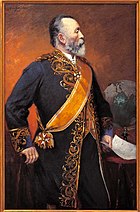



Early times[edit]
- Erdmuthe of Brandenburg(1561–1623), Princess of Brandenburg, died in Stolp
- Michael Brüggemann(1583–1654), German Lutheran pastor, preacher and translator
- Matthias Palbitzki(1623–1677), Swedish diplomat and art-connoisseur
- Andrzej Stech(1635–1697), Polish Baroque painter
- Eduard von Bonin(1793–1865), Prussian General, minister of war
19th century[edit]
- Heinrich von Stephan(1831–1897), German official, founder of theUniversal Postal Union[48]
- Berthold Suhle(1837–1904), German chess master
- Wilhelm Dames(1843–1898), German paleontologist
- Otto Liman von Sanders(1855–1929), German general
- Georg von der Marwitz(1856–1929), German general
- Hedwig Lachmann(1865–1918), German author, translator and poet
- Hans Schrader(1869–1948), German classical archaeologist and art historian
- Erwin Bumke(1874–1945), German jurist
- Oswald Bumke(1877–1950), German psychiatrist, neurologist
- Otto Freundlich(1878–1934), German painter and sculptor, an abstract artist
- Walter Lichel(1885–1969) German general
- George Grosz(1893–1959), German artist, satirical caricaturist
20th century[edit]
- Paul Mattick(1904–1981), American Marxist political writer
- Flockina von Platen(1905–1984), German actress
- Mieczysław Kościelniak(1912–1993), Polish painter, graphic designer and draftsman
- Bronisław Kostkowski(1915–1942), Polish Roman Catholic seminarian
- Odo Marquard(1928–2015), German philosopher, a member of theRitter School
- Christian Meier(born 1929), German historian
- Edgar Wisniewski(1930–2007), German architect
- Bazon Brock(born 1936), German art theorist, critic and artist; member ofFluxus
- Dieter Stöckmann(born 1941), German general
- Jörg Schmeisser(1942–2012), German printmaker
- Simone Barck(1944–2007), German contemporary historian and literary scholar
- Ulrich Beck(1944–2015), German sociologist
- Grażyna Auguścik(born 1955), Polish jazz vocalist, composer, and arranger
- Jolanta Szczypińska(1957–2018), Polish politician
- Edward Müller(born 1958), Polish politician and trade union activist
- Przemysław Gosiewski(1964–2010), Polish politician, deputy chair of Law and Justice party
- Tomasz Malinowski(born 1965), Polish-American diplomat and U.S. Congressman and politician
- Sarsa Markiewicz(born 1989), Polish singer, songwriter and record producer
- Sport
- Heinz Radzikowski(1925–2017) a German field hockey player, competed in the1956 Summer Olympics
- Harry Klugmann(born 1940) a German equestrian and Olympic medallist at the1972 Summer Olympics
- Halina Aszkiełowicz-Wojno(1947–2018) Polish volleyball player, bronze medalist1968 Summer Olympics
- Darius Grala(born 1964) an endurance sports car racing driver in the USA
- Robert Kraskowski(born 1967) a Polish sport shooter, competed at the1992and1996 Summer Olympics
- Mirosława Sagun-Lewandowska(born 1970) air gun champion, participant in three Olympic Games
- Tomasz Iwan,(born 1971) Polish football (soccer) player
- Dariusz Ulanowski,(born 1971) Polish former football (soccer) player
- Maciej Stolarczyk,(born 1972), Polish former football (soccer) player, and currentlyfootball manager
- Paweł Kryszałowicz(born 1974), Polish footballer, represented Poland in 33 matches scoring 10 goals
- Milena Rosner(born 1980), volleyball player, participant in the2008 Summer Olympics
- Kamila Augustyn(born 1982), Polish badminton player, competed at the2008and2012 Summer Olympics
- Wojciech Jarmuż(born 1984), Polish footballer
- Miłosz Bernatajtys(born 1982), Polish rower, silver medallist at the2008 Summer Olympics
International relations[edit]
Słupsk istwinnedwith:
 Bari,Italy
Bari,Italy Bukhara,Uzbekistan
Bukhara,Uzbekistan Carlisle,United Kingdom[49][50]
Carlisle,United Kingdom[49][50] Cartaxo,Portugal
Cartaxo,Portugal Flensburg,Germany
Flensburg,Germany Ustka,Poland
Ustka,Poland Vantaa,Finland
Vantaa,Finland Vordingborg,Denmark
Vordingborg,Denmark
Former twin towns:
 Arkhangelsk,Russia (terminated in 2022 due to theRussian invasion of Ukraine)[51]
Arkhangelsk,Russia (terminated in 2022 due to theRussian invasion of Ukraine)[51] Grodno,Belarus (terminated in 2022 due to the country'sinvolvement in the Russian invasion of Ukraine)[51]
Grodno,Belarus (terminated in 2022 due to the country'sinvolvement in the Russian invasion of Ukraine)[51]
See also[edit]
References[edit]
- Literature
- (in German)Helge Bei der Wieden and Roderich Schmidt, eds.:Handbuch der historischen Stätten Deutschlands: Mecklenburg/Pommern,Kröner, Stuttgart 1996,ISBN978-3-520-31501-4,pp. 287–290.
- (in German)Haken, Christian Wilhelm:Drei Beiträge zur Erläuterung der Stadtgeschichte von Stolp(Three Contributions to Explaining the History of the Town of Stolp) (1775). Newly edited by F. W. Feige, Stolp, 1866 (online)
- (in German)Kratz, Gustav:Die Städte der Provinz Pommern, Abriss ihrer Geschichte, zumeist nach Urkunden(The Towns of the Province of Pomerania - Sketch of their History, Mainly According to Historical Records). Berlin, 1865 (reprinted in 2010 byKessinger Publishing,ISBN1-161-12969-3), pp. 413–439 (online)
- (in German)Pagel, Karl-Heinz:Stolp in Pommern - eine ostdeutsche Stadt.Lübeck, 1977 (with extensive bibliography,online)
- (in German)Reinhold, Werner:Chronik der Stadt Stolp(Chronicle of the Town of Stolp). Stolp, 1861 (online)
- Notes
- ^ab"Local Data Bank".Statistics Poland.Retrieved11 August2022.Data for territorial unit 2263000.
- ^Collaborative work (2007).Powierzchnia i ludność w przekroju terytorialnym w 2007(in Polish). Central Statistical Office.
- ^Collaborative work (1999).Gminy w Polsce(in Polish). Central Statistical Office.
- ^abc"Słupsk.pl:Informacje ogólne"(in Polish). Archived fromthe originalon October 13, 2007.RetrievedApril 12,2008.
- ^"Nasze Kaszuby: Zestawienie kaszubskich i polskich nazw miejscowości na Kaszubach, z wariantami, z wyszczególnieniem powiatów"(in Polish and Kashubian).RetrievedApril 12,2008.
- ^"Lexicon Universale"(in Latin).RetrievedApril 12,2008.[dead link]
- ^abcdefg[1]Archived2010-08-26 at theWayback MachineHistoria Słupska do roku 1945. Official webpage of the city. (in Polish)
- ^"Nasze miasto - Słupsk".Archived fromthe originalon 2014-12-20.Retrieved2009-08-07.Historia. Official webpage of the city
- ^abSchmidt, Roderich (2009).Das historische Pommern. Personen, Orte, Ereignisse.Veröffentlichungen der Historischen Kommission für Pommern (in German). Vol. 41 (2 ed.). Köln-Weimar: Böhlau. p. 140.ISBN978-3-412-20436-5.
- ^Schmidt, Roderich (2009).Das historische Pommern. Personen, Orte, Ereignisse.Veröffentlichungen der Historischen Kommission für Pommern (in German). Vol. 41 (2 ed.). Köln-Weimar: Böhlau. p. 142.ISBN978-3-412-20436-5.
- ^Schmidt, Roderich (2009).Das historische Pommern. Personen, Orte, Ereignisse.Veröffentlichungen der Historischen Kommission für Pommern (in German). Vol. 41 (2 ed.). Köln-Weimar: Böhlau. pp. 142, 147.ISBN978-3-412-20436-5.
- ^abcSchmidt, Roderich (2009).Das historische Pommern. Personen, Orte, Ereignisse.Veröffentlichungen der Historischen Kommission für Pommern (in German). Vol. 41 (2 ed.). Köln-Weimar: Böhlau. p. 147.ISBN978-3-412-20436-5.
- ^abcdSchmidt, Roderich (2009).Das historische Pommern. Personen, Orte, Ereignisse.Veröffentlichungen der Historischen Kommission für Pommern (in German). Vol. 41 (2 ed.). Köln-Weimar: Böhlau. p. 148.ISBN978-3-412-20436-5.
- ^"Słupsk.pl:Historia Słupska do roku 1945"(in Polish). Archived fromthe originalon July 18, 2011.RetrievedApril 12,2008.
- ^Schmidt, Roderich (2009).Das historische Pommern. Personen, Orte, Ereignisse.Veröffentlichungen der Historischen Kommission für Pommern (in German). Vol. 41 (2 ed.). Köln-Weimar: Böhlau. pp. 143–144.ISBN978-3-412-20436-5.
- ^Schmidt, Roderich (2009).Das historische Pommern. Personen, Orte, Ereignisse.Veröffentlichungen der Historischen Kommission für Pommern (in German). Vol. 41 (2 ed.). Köln-Weimar: Böhlau. pp. 144–145.ISBN978-3-412-20436-5.
- ^Friedrich Wilhelm Barthold,Geschichte von Rügen und Pommern,1842, p. 156
- ^Juliusz Bardach,Historia państwa i prawa Polski, Volume 1,Państwowe Wydawn. Naukowe, 1964, p. 589
- ^Werner Buchholz, Pommern, Siedler, 1999, p.211,ISBN3-88680-272-8
- ^Język polski, Tomy 19-20 Towarzystwo Miłośników Języka Polskiego, page 194, W Drukarni Uniwersytetu Jagiellońskiego, 1999
- ^Polacy i Niemcy wobec siebieStanisław Salmonowicz,Ośrodek Badań Naukowych im. W. Kętrzyńskiego 1993, page 43
- ^Edda Gutsche (2018).Mit Ausblick auf Park und See. Zu Gast in Schlössern und Herrenhäusern in Pommern und der Kaschubei(in German). Elmenhorst/Vorpommern: edition Pommern. p. 63.ISBN978-3-939680-41-3.
- ^"Deutsche Verwaltungsgeschichtevon der Reichseinigung 1871 bis zur Wiedervereinigung 1990 von Dr. Michael Rademacher M.A."Archived fromthe originalon 2011-07-23.Retrieved2011-08-08.
- ^abcdSłupsk po wybuchu II wojny światowej
- ^[2]Archived2010-08-26 at theWayback MachineSłupsk po wybuchu II wojny światowej. Official city webpage
- ^Lakotta, Beate (2005-03-05)."Tief vergraben, nicht dran rühren".SPON(in German). Archived fromthe originalon 2020-04-17.Retrieved2010-08-16.
- ^abcde"Nasze miasto - Słupsk".Archived from the original on 2014-05-06.Retrieved2019-06-09.
{{cite web}}:CS1 maint: bot: original URL status unknown (link)Historia Słupska po roku 1945. Official webpage of the city (in Polish) - ^"Pizza Słupsk Info".Archived fromthe originalon August 6, 2018.RetrievedJune 9,2019.
- ^"Legislative proposal of July 24, 1998, regarding the introduction of the three-level administrative division of Poland"(in Polish).RetrievedApril 22,2008.
- ^Gera, Vanessa (1 December 2014)."Poland elects first openly gay mayor in elections".The Big Story.Associated Press.Archivedfrom the original on 3 December 2014.Retrieved1 December2014.
- ^"Gp24.pl:Coraz bliżej aquaparku"(in Polish). 23 September 2007.RetrievedApril 13,2008.
- ^Kaczmarek, T., Kaczmarek, U., Sołowiej D., Wrzesiński, D. (2002).Ilustrowana Geografia Polski(in Polish). Świat Książki.
{{cite book}}:CS1 maint: multiple names: authors list (link) - ^Collaborative work (2000).Altas geograficzny dla szkół średnich(in Polish). PPWK.
- ^ "Średnie i sumy miesięczne"(in Polish). Meteomodel.pl. 6 April 2018.Retrieved22 July2022.
- ^ "Średnie i sumy miesięczne"(in Polish). Meteomodel.pl. 6 April 2018.Retrieved22 July2022.
- ^"Slupsk, Poland – Detailed climate information and monthly weather forecast".Weather Atlas.Retrieved1 August2022.
- ^"Climate & Weather Averages in Słupsk".Time and Date.Retrieved24 July2022.
- ^"Kolej.One.Pl:Słupsk"(in Polish).RetrievedApril 22,2008.
- ^"List of stations maintained by Dworce Kolejowe"(PDF)(in Polish). Archived fromthe original(PDF)on January 9, 2006.RetrievedApril 22,2008.
- ^"SKM network map"(in Polish). Archived fromthe originalon April 20, 2008.RetrievedApril 22,2008.
- ^abcdefghiKratz (1865),p. 430
- ^Meyers Konversations-Lexikon.6th edition, vol. 19, Leipzig and Vienna 1909, p. 60(in German)
- ^Gunthard Stübs und Pommersche Forschungsgemeinschaft:Die Stadt Stolp im ehemaligen Stadt Stolp in PommernArchived2013-01-09 at theWayback Machine,2011.(in German)
- ^abverwaltungsgeschichte.deArchived2011-07-23 at theWayback Machine(in German)
- ^Protesters March on Proposed US Missile Base
- ^President Obama announces scrapping the planned missile defense system in Poland and the Czech RepublicNew York TimesRetrieved on 09-17-09
- ^[3][4]Defense Industry DailyRetrieved on 02-18-16
- ^Chisholm, Hugh,ed. (1911)..Encyclopædia Britannica.Vol. 25 (11th ed.). Cambridge University Press. p. 879.
- ^Carlisle City Council."Town twinning".carlisle.gov.uk. Archived fromthe originalon 2008-12-02.Retrieved2009-06-24.
- ^"Town Twinning at Carlisle City Council".carlisletwins.org.uk. Archived fromthe originalon 2007-08-27.Retrieved2009-06-24.
- ^ab"Słupsk zakończył współpracę z rosyjskim Archangielskiem i białoruskim Grodnem"(in Polish). 2 March 2022.Retrieved9 March2022.
External links[edit]
- .Encyclopædia Britannica.Vol. 25 (11th ed.). 1911. p. 955.
- Municipal websiteArchived2008-09-09 at theWayback Machine
- Museum of Central Pomerania
- History of Slupsk
- Solidarity International Bridge Festival
- March 29th, 2008: Demonstration Against U.S. Missile Defence Shield












